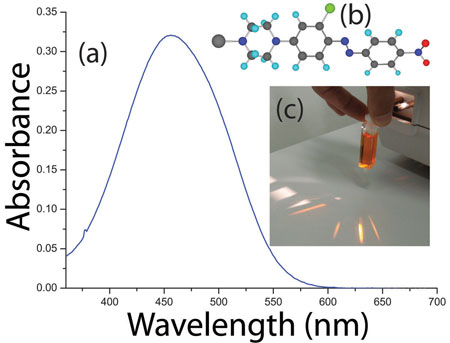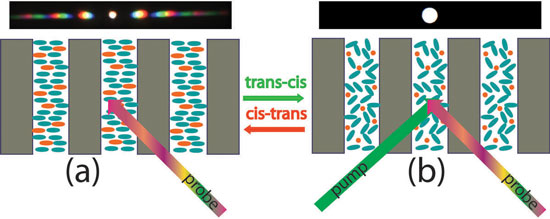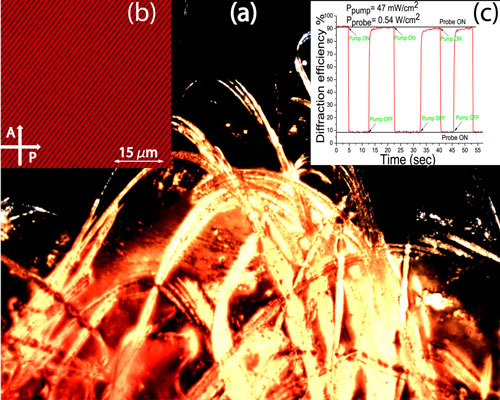| Posted: Apr 04, 2012 | |
Controlling the diffraction of light by using light |
|
| (Nanowerk Spotlight) All-optical processes could allow dramatic speed increase in photonics by eliminating the need to convert photonic signals to electronic signals and back for switching. The many opportunities that all-optical processes could bring to photonics have been hampered by the lack of materials that combined photosensitivity with fast, large, and reversible changes in their optical properties at the influence of light. | |
| Photosensitive Liquid Crystals (PLCs) contain an azo group in their mesogenic structure, thus blending the photosensitivity of azobenzene compounds with the high birefringence of LCs. By exposing PLCs to radiation of, typically, blue-green wavelengths, they undergo a conformational transformation (trans-cis photoisomerization) with dramatic changes of macroscopic optical properties of the material. Furthermore, PLCs exhibit a high solubility in LCs as opposed to non-mesogenic azo-dyes (see paper in Journal of Materials Chemistry: "Mesogenic versus non-mesogenic azo dye confined in a soft-matter template for realization of optically switchable diffraction gratings"). | |
| Moreover, high concentrations of PLCs in LCs do not affect their order parameter and no phase separation or change in boundary conditions is induced. | |
| Finally, the effect of photoisomerization of PLCs on the host medium is much stronger than that of non-mesogenic dopants. The latter in fact, act as impurities reducing the order parameter of the host LC material and exhibiting a tendency to separate from the LC, sedimenting on the boundaries, thus changing the boundary conditions. On the contrary, not only does a high concentration of PLCs yield high photosensitivity, but it also speeds up the switching process, since less time is needed to induce a macroscopic change in the optical properties of the material as a result of molecular photoexcitation. | |
 |
|
| Figure 1: (a) Visible spectrum of CPND-57 mesogenic azo-dye dissolved in THF. (b) 3 D chemical structure of CPND-57. (c) Photo of the solution under external white light illumination in a quartz cuvette. (Image: Luciano De Sio, University of Calabria) | |
| "CPND-57" is a new generation of PLC composition based on piperazine-based push-pull LC azo dyes CPND 5 and CPND 7 (see paper in Journal of Materials Chemistry: "Photo-sensitive liquid crystals for optically controlled diffraction gratings"). In Fig 1a we show the absorption spectrum of the pure CPND-57 (dissolved in tetrahydrofuran) with an absorption peak centred at λmax= 460 nm. | |
| The functions of LC optical devices are determined by the orientation of the LC as well as the topology of its confinement. Polymeric microstructures have been produced for micro/nano confinement of a wide variety of organic materials, stabilized through self-organization processes at nanoscale. We recently exploited the universal capabilities of an "active polymeric template" for confining, orienting, and stabilizing a wide range of self-organized materials (see paper in Soft Matter: "Universal soft matter template for photonic applications"). | |
| By doing so, we have exploited a wide range of optical, electro-optical and all-optical effects which confirm the extraordinary capability of our "active polymeric template" to induce self-organization, without using any kind of surface chemistry or functionalization. In particular, by infiltrating the "active polymeric template" with PLCs, we have exploited the fascinating possibility of controlling the diffraction of light – through a micro-periodic structure – by using another light source. | |
 |
|
| Fig 2: Photoisomerization processes taking place inside the active polymeric structure that undergoes different irradiation regimes. (Image: Luciano De Sio, University of Calabria) | |
| Figure 2 shows a schematic representation of the all-optical control process due to the refractive index contrast of the "active polymeric template" infiltrated with PLC. By using a multi-line laser beam as a probe (Fig. 2a), it is possible to observe the diffractive properties (see typical color diffraction pattern) due to the high index contrast between the PLC films and the polymer slices. By irradiating with a green pump laser over the spot of the multi-line laser beam (Fig. 2b), it is possible to induce the trans-cis isomerization of the azo dye, which tends to destabilize the PLC order. In this case, the structure shows an almost vanishing index contrast and becomes transparent to the impinging probe light (see white transmission spot). However, when the green pump beam is turned off, the probe light itself is able to induce a reverse (cis?trans) isomerization process and the PLC order is well restored. | |
 |
|
| Fig 3: POM view of random (a) and uniform (b) aligned azo-LC. (c) All-optical response of the structure. (Image: Luciano De Sio, University of Calabria) | |
| The "solar flares" in Figure 3a is a Polarized Optical Microscope (POM) view of a droplet of a PLC deposited on a glass substrate, without using any kind of surface chemistry or treatment. The PLC, however, is well aligned by the template. The excellent optical quality of the template infiltrated with PLC is evident in the POM view shown in Figure 3b. We demonstrated (see paper in Advanced Materials: "Composite Holographic Gratings Containing Light-Responsive Liquid Crystals for Visible Bichromatic Switching") optically switchable gratings for polarized diffraction by means of a standard pump-probe optical setup, using a green (514 nm wavelength) pump laser and He-Ne probe beams (633 nm). These high efficiency gratings, Fig. 3c, can be switched on and off all-optically in µs-ms time scale. | |
| Thus, without using functionalized surfaces, our polymeric template comprising a well defined regular structure of polymer walls provides an extraordinary capability of confining and inducing organization of a PLC required for high performance all-optical switching. | |
| By Luciano De Sio, Loredana Ricciardi, Nelson Tabiryan (BEAM Co), and Cesare Umeton, University of Calabria. | |
|
Become a Spotlight guest author! Join our large and growing group of guest contributors. Have you just published a scientific paper or have other exciting developments to share with the nanotechnology community? Here is how to publish on nanowerk.com. |
|
